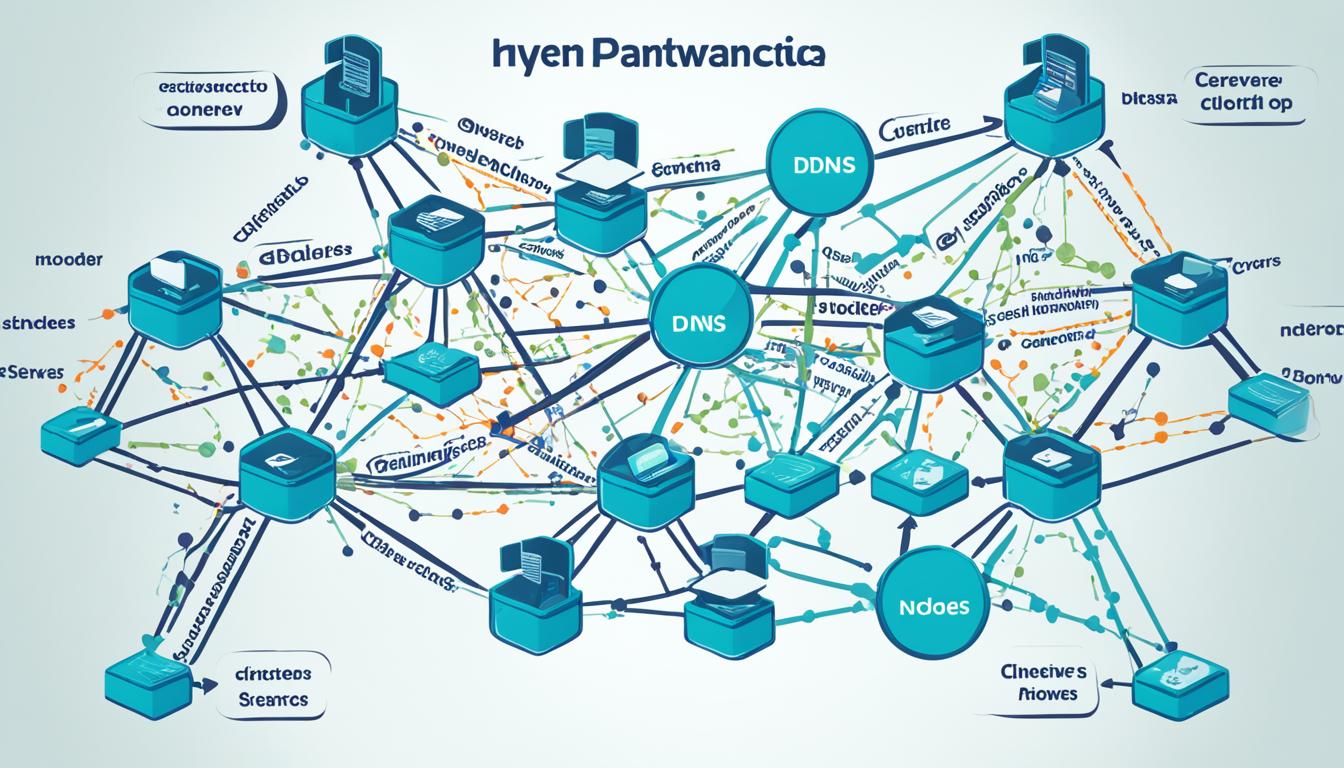Name of servers: what is this?
Without them, the internet as we know it would not be possible. Name servers play a vital role in translating human-readable domain names into numeric IP addresses, allowing computers to easily locate and connect to websites on the internet.
But what exactly are name servers, and how do they work? In this article, I will delve into the world of name servers, explaining their importance, functionalities, and how they contribute to the smooth operation of the internet.
Key Takeaways:
- Name servers are computer applications responsible for translating domain names into IP addresses.
- Name servers are a crucial component of the Domain Name System (DNS) and facilitate the easy accessibility of websites on the internet.
- Knowing your site’s name servers can help troubleshoot and manage domain and hosting configurations.
- Online tools and command line tools like nslookup or dig can be used to look up your site’s name servers.
- Maintaining and securing name servers is essential to prevent disruptions and unauthorized access.
The Role of Name Servers in the Internet
Name servers play a pivotal role in powering the internet. They act as a directory that translates domain names into IP addresses, enabling web browsers to locate and connect to websites. These servers hold the DNS records that associate domain names with their corresponding IP addresses. There are various types of name servers, each serving a specific function in the DNS hierarchy and contributing to the smooth operation of the internet.
- Authoritative Name Servers: These servers are responsible for storing the authoritative DNS records of a domain. They provide the definitive answers to DNS queries and are the top-level source of information for a specific domain.
- Caching Name Servers: Caching name servers store recently accessed DNS information in their cache. When a user requests a specific domain name, these servers check their cache first for a quick response. If the record is not found in the cache, they retrieve it from authoritative name servers.
- Recursive Name Servers: When a caching name server does not have the requested DNS record, it contacts a recursive name server. Recursive name servers perform the necessary steps to resolve the DNS query by recursively contacting different authoritative name servers until the IP address is found.
The collaboration between these types of name servers ensures efficient and accurate domain name resolution, enabling users to access websites with ease. Without name servers, the internet as we know it would not be possible.
| Name Server Type | Functionality |
|---|---|
| Authoritative Name Servers | Store authoritative DNS records for a specific domain. |
| Caching Name Servers | Store recently accessed DNS records in their cache for quick retrieval. |
| Recursive Name Servers | Resolve DNS queries by recursively contacting authoritative name servers. |
How Name Servers Work
When a user enters a domain name in their web browser, the browser sends a request to the name server associated with that domain. The name server translates the domain name into an IP address and returns it to the browser. The browser then uses the IP address to connect to the appropriate web server and retrieve the requested website.
Name servers play a crucial role in server hosting and server management. They are responsible for ensuring the proper routing of internet traffic and facilitating the connection between domain names and IP addresses. Without name servers, users would not be able to access websites by typing in their domain names alone.
Name servers can be managed by domain registrars or web hosting providers. It is their responsibility to maintain and update the name server configurations to ensure smooth and reliable domain name resolution. By effectively managing the name servers, they ensure that websites are accessible to users and that internet traffic is routed efficiently.
In addition to translating domain names into IP addresses, name servers also play a role in caching and optimizing DNS queries. Caching name servers store recently accessed DNS information, allowing them to respond to future queries more quickly. This helps to improve website loading speeds and overall user experience.
Proper server management and regular maintenance of name servers are essential in ensuring their optimal performance and security. This includes implementing security measures, such as firewalls and intrusion detection systems, to protect against potential threats and unauthorized access.
In summary, name servers are the backbone of the internet infrastructure. They translate domain names into IP addresses, play a crucial role in server hosting and server management, and are responsible for the proper routing of internet traffic. By effectively managing and maintaining name servers, domain registrars and web hosting providers ensure that websites are accessible and internet traffic flows smoothly.
Setting Up Name Servers
Setting up name servers is an essential step in configuring the Domain Name System (DNS) records for your domain. This process involves specifying the IP addresses of the name servers that will handle DNS queries for your domain.
The exact steps for setting up name servers may vary depending on your domain registrar or web hosting provider. However, the general procedure involves accessing your domain settings and entering the IP addresses of the name servers provided by your hosting provider.
It is crucial to prioritize server maintenance and security when setting up name servers. Regular maintenance ensures the smooth operation of your servers, reducing the risk of downtime and optimizing performance. Additionally, maintaining up-to-date security measures helps safeguard your servers against potential threats, ensuring the confidentiality and integrity of your website and user data.
To demonstrate the importance of server protection, here is a table highlighting common server security vulnerabilities:
| Vulnerability | Impact |
|---|---|
| Weak Passwords | Allows unauthorized access and potential data breaches. |
| Outdated Software | Leads to unpatched security vulnerabilities that can be exploited by attackers. |
| Insufficient Firewall Configuration | Leaves your server exposed to unauthorized network access. |
| Inadequate Backup Procedures | Puts your data at risk of permanent loss in case of server failure or data corruption. |
By prioritizing server maintenance and security, you can minimize the risk of server-related issues and ensure the smooth and secure operation of your website.

Next Steps: Server Maintenance and Security Checklist
To maintain the optimal performance and security of your name servers, consider implementing the following best practices:
- Regularly update server software and apply security patches.
- Use strong, unique passwords and consider implementing multi-factor authentication.
- Configure firewalls to restrict access to your servers and network.
- Regularly back up your server data to a secure off-site location.
- Monitor server logs and network traffic for any suspicious activity.
- Consider employing a reputable server management service for proactive maintenance and security monitoring.
By following these recommendations, you can ensure that your name servers are well-maintained and secure, providing a reliable foundation for your online presence.
Importance of Knowing Your Site’s Name Servers
Understanding your website’s name servers may not be essential for everyone, but it can prove to be advantageous when it comes to troubleshooting and managing domain and hosting configurations. By gaining knowledge about your site’s name servers, you can grasp the concept of domain name resolution and make any necessary changes or updates to enhance your online presence. Furthermore, being aware of your name server configuration plays a vital role in identifying and resolving potential issues related to website accessibility and performance.

| Benefits of Knowing Your Site’s Name Servers |
|---|
| 1. Troubleshooting: By knowing your name servers, you can pinpoint and troubleshoot any issues related to DNS resolution, connectivity, or server configurations. |
| 2. Configuration Management: Understanding your name server settings allows you to manage your domain and hosting setup effectively. You can make changes like setting up subdomains, email hosting, or pointing your domain to a different server. |
| 3. Website Updates: Having knowledge of your name server configuration enables you to update or modify DNS records to enhance website functionality or implement security measures like SSL certificates. |
| 4. Troubleshoot Accessibility Issues: In case your website experiences accessibility problems, knowing your name servers can help identify if the issue lies with DNS propagation or any misconfigurations. |
By familiarizing yourself with your site’s name servers, you gain greater control over your online presence and can address any technical challenges more effectively. It empowers you to optimize your website’s performance, accessibility, and security, ensuring a seamless experience for your visitors.
How to Look Up Your Site’s Name Servers
If you’re curious about which name servers your domain is using, there are convenient online tools available for name server lookup. These tools allow you to simply enter your domain name and quickly retrieve the associated name server information. By utilizing these resources, you can gain valuable insights into the server technology supporting your website.
Alternatively, you can perform a DNS lookup using command line tools like nslookup or dig. These command line tools provide a more in-depth analysis of the name servers associated with a specific domain, including their IP addresses. Through this method, you can easily access your site’s name server information and effortlessly verify its configuration.
Discovering and understanding your site’s name servers is important for effective server management and maintenance. Armed with this knowledge, you can confidently troubleshoot any issues that may arise and make informed decisions about your website’s hosting and domain configurations. It empowers you to take control of your server technology and ensure optimal performance for your digital presence.
FAQ
What is the purpose of name servers?
What types of name servers exist?
How do name servers work?
How do I set up name servers for my domain?
Why is it important to know my site’s name servers?
How can I find out which name servers my domain is using?
- How Strategic SEO Drove Growth for a CPAP E-commerce Brand - July 24, 2025
- Top 3 SEO Companies in Toronto: An Analytical Comparison - July 23, 2025
- SEO for Entry Door Services - April 24, 2025





















Post Comment
You must be logged in to post a comment.